|

|
|
| |
|
China Oil Painting Direct
|
|
100% hand painted, 100%
cotton canvas,
100% money back if not satisfaction.
|
|
|
|
ART WORKS
INDEX
A B C D E F G H I J K L M N O P Q R S T U V W X Y Z
|
|
ARTISTS
INDEX
A B C D E F G H I J K L M N O P Q R S T U V W X Y Z
|
|
|
|
 |
Isaac Cruikshank 
|
|
English Illustrator, ca.1756-1811
Scottish painter and caricaturist, was born in Edinburgh. His sons Isaac Robert Cruikshank (1789-1856) and George Cruikshank also became artists, and the latter in particular achieved fame as an illustrator and caricaturist. Cruikshank is known for his social and political satire. His parents were Elizabeth Davidson (b. c.1725), daughter of a gardener, and Andrew Crookshanks (c.1725 Cc.1783), a former customs inspector dispossessed for his role in the Jacobite uprising of 1745. He studied with a local artist, possible John Kay (1742 C1826), and travelled with his master to London in 1783. He married Mary MacNaughton (1769 C1853) in 1788 and the couple had five known children, two of whom died in infancy. A daughter, Margaret Eliza, also a promising artist, died at the age of eighteen. Cruikshank's first known publications were etchings of Edinburgh "types", from 1784. He produced illustrations for books about the theatre, did the frontispiece for Witticisms and Jests of Dr Johnson (1791), and illustrated George Shaw's extensive General Zoology (1800 C26). His watercolours were exhibited, but in order to make a living it was more lucritive to produce prints and caricatures. He was responsive to the marketplace but firm in his dislikes of Napoleon and political radicals. He and Gillray developed the figure of John Bull, the nationalistic representation of a solid British yeoman. Publisher John Roach was a friend and patron, and he later worked with print dealer S. W. Fores and Johnny Fairburn. He also collaborated, with G. M. Woodward, and later, with his son George. Cruikshank died of alcohol poisoning at the age of fifty-five as a result of a drinking contest and is buried near his home in London.
|
|
 |
J.-B. Charpentier 
|
|
|
|
 |
J.L.Clark 
|
|
British 19th c
|
|
 |
Jacob Carl Stauder 
|
|
(1694 -1756 ) - Painter
|
|
 |
Jacob Claesz van Utrecht 
|
|
also named by his signature Jacobus Traiectensis (born c. 1479 - dead after 1525) was a Flemish early Renaissance painter who worked in Antwerp and Lebeck.
Jacob van Utrecht's life is still very much in the dark. Research on this important Flemish artist did not start before the end of 19th century. He was probably born in Utrecht, although it is not certain. It is assumed that he became a citizen of Antwerp around 1500 and he is recorded as a "free master craftsman" of the Guild of St Luke there from 1506 to 1512.
From 1519 to 1525 he is recorded as a member of the Leonardsbruderschaft ("Leonard's Brotherhood"), a religious confraternity of merchants in Lebeck among whose ranks the leaders of the Protestant Reformation in the 1530s could be found.
From then on no traces of his life have been found.
|
|
 |
Jacob Gerritsz Cuyp 
|
|
1594-1652
Dutch
Jacob Gerritsz Cuyp Locations
Painter and draughtsman. Probably taught by his father, he entered the Guild of St Luke in Dordrecht in 1617, the same year that he executed an important commission to portray the masters of the Holland Mint (Dordrecht, Mus. van Gijn). He was the Guild bookkeeper in 1629, 1633, 1637 and 1641 and, according to Houbraken, led Dordrecht fine painters in their separation from the Guild in 1642. Jacob married Aertken van Cooten from Utrecht in 1618; his only child, (3) Aelbert Cuyp, was born two years later.
|
|
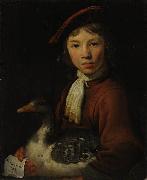 |
Jacob Gerritsz. Cuyp 
|
|
was a portrait and landscape painter. He was born and died in Dordrecht, and was the half-brother of Benjamin Gerritsz Cuyp and the father of the much more famous Aelbert Cuyp.
According to Houbraken, he helped the painters Jacques de Claeuw, Isaac van Hasselt, and Cornelis Tegelberg set up a Guild of Saint Luke in Dordrecht in 1642.
|
|
 |
Jacopino del Conte 
|
|
Italian Painter, ca.1510-1598
was an eminent Italian Mannerist painter, active in both Rome and Florence. A native of Florence, Jacopino del Conte was born the same year as another Florentine master Cecchino del Salviati (whom Conte outlived by 35 years) and, like Salviati and a number of other painters, he initially apprenticed with the influential painter and draftsman Andrea del Sarto. Conte's first frescoes, including Annunciation to Zachariah (1536), Preaching of Saint John the Baptist (1538), and Baptism of Christ (1541) were in the Florentine-supported Oratory of San Giovanni Decollato, located in Rome. The Preaching fresco was based on a drawing by Perin del Vaga. In 1547?C48, in collaboration with Siciolante da Sermoneta, Conte completed the fresco decoration of the chapel of San Remigio in San Luigi dei Francesi. In 1552, he painted another work for the San Giovanni Decollato Oratory, the altarpiece Deposition, whose designs are sometimes attributed to Daniele da Volterra.
|
|
 |
Jacopo Chimenti 
|
|
(30 April 1551 - 30 September 1640) was an Italian late-mannerist painter.
Born in Florence as Jacopo Chimenti (Empoli being the birth place of his father), he worked mostly in his native city. He apprenticed under Maso da San Friano. Like his contemporary in Counter-Maniera (Counter-Mannerism), Santi di Tito, he moved into a style often more crisp, less contorted, and less crowded than mannerist predecessors like Vasari. He collaborated with Alessandro Tiarini in some projects. Among his pupils were Felice Ficherelli, Giovanni Battista Brazze (Il Bigio), Giovanni Battista Vanni, and Virgilio Zaballi.
In later years, the naturalism becomes less evident. The porcelain features of his figures accentuated the academic classical trends that restrained Florentine painting during the Baroque period.
|
|
 |
Jacopo del Casentino 
|
|
Italian Gothic Era Painter, ca.1297-1358
|
|
 |
Jacopo di Arcangelo called jacopo del sellajo 
|
|
Florence 1441/2-1493
|
|
 |
Jacopo Di Cione 
|
|
Italian Byzantine Style Painter, ca.1330-1398
|
|
 |
Jacques Charlier 
|
|
French Miniaturist, ca.1705-1790
|
|
 |
Jacques Courtois 
|
|
(also called 'il Borgognone' or Giacomo Borgognone) (1621 - 20 May 1676?) was a French painter.
He was born at Saint-Hippolyte, near Besançon. His father was a painter, and with him Jacques remained studying up to the age of fifteen. Towards 1637 he went to Italy, was received at Milan by a Burgundian gentleman, and entered, and for three years remained in the French military service.
The sight of some battle-pictures revived his taste for fine art. He went to Bologna, and studied under the friendly tutelage of Guido Reni; thence he proceeded to Rome, where he painted, in the Cistercian monastery, the "Miracle of the Loaves." Here he took a house and after a while entered upon his own characteristic style of art, that of battle-painting, in which he has been accounted to excel all other old masters; his merits were cordially recognized by the celebrated Cerquozzi, named Michelangelo delle Battaglie.
He soon rose from penury to ease, and married a painter's daughter, Maria Vagini; she died after seven years of wedded life. Prince Matthias of Tuscany employed Courtois on some striking works in his villa, Lappeggio, representing with much historical accuracy the princes military exploits. In Venice also the artist executed for the senator Sagredo some remarkable battle-pieces. In Florence he entered the Society of Jesus, taking the habit in Rome in 1655; it was calumniously rumoured that he adopted this course in order to escape punishment for having poisoned his wife.
As a Jesuit Brother, Courtois painted many works in churches and monasteries of the society. He lived piously in Rome, and died there of apoplexy on 20 May 1676 (some accounts say 1670 or 1671).
His battle-pieces have movement and fire, warm colouring (now too often blackened), and great command of the brush, those of moderate dimensions are the more esteemed. They are slight in execution, and tell out best from a distance. Courtois etched, with skill twelve battle-subjects of his own composition. The Danzig painter called Pandolfo Reschi in Italy was his pupil.
His brother Guillaume was also a painter in Italy.
|
|
 |
James Caldwall 
|
|
British b.1739 d. in or after 1819
|
|
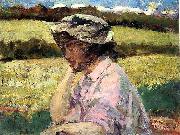 |
James Carroll Beckwith 
|
|
(September 23, 1852 - October 24, 1917) was an American landscape, portrait and genre painter whose Impressionist style led to his recognition in the late nineteenth century as a prominent figure in American art.
Carroll Beckwith, as he preferred to be known, was born in Hannibal, Missouri on 23 September 1852, the son of N. M. Beckwith, who was United States Commissioner-General at the Paris Exposition of 1867. However, he grew up in Chicago where his father started a wholesale grocery business. In 1868 aged 16 he studied art at the Chicago Academy of Design under Walter Shirlaw until the great fire of 1871 destroyed eveything (including much of the heart of the city). He then went to New York and studied at the National Academy of Design (of which he afterwards became a member) in New York City under Lemuel Wilmarth and later traveled on to Paris, staying there from November 1873 until 1878.
|
|
 |
James Charles 
|
|
English Painter, 1851-1906
|
|
|
|
James clarke hook,r.a 
|
|
1819-1907
English painter. He studied with the portrait painter John Jackson and entered the Royal Academy Schools, London, in 1836, winning medals for drawing and historical painting. His Academy d?but was in 1839 with The Hard Task (untraced). In 1844 Hook was awarded a gold medal in the Houses of Parliament competition. In 1846 he won a Royal Academy travelling scholarship, enabling him to spend two years in Italy, where he was strongly influenced by the colouring of the Venetian painters. On his return his work included a series of subjects from Venetian history, including The Rescue of the Brides of Venice
|
|
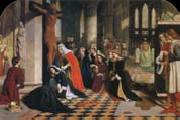 |
James Collinson 
|
|
English Pre-Raphaelite Painter, 1825-1881
English painter. He was the son of a Nottinghamshire bookseller. He studied at the Royal Academy Schools, London, where he was a fellow student of Dante Gabriel Rossetti and William Holman Hunt. Although quiet and unobtrusive, he caught the attention of critics when he exhibited the Charity Boy De but at the Royal Academy in 1847 (sold London, Christie, 26 Oct 1979, lot 256). The painting was praised for its truthfulness and use of minute detail. It was admired by Rossetti, who sought out Collinson and befriended him. The following year saw the formation of the Pre-Raphaelite Brotherhood (PRB), which Rossetti invited Collinson to join. Around this date Collinson renounced Catholicism and became engaged to Christina Rossetti; possibly this influenced the other members of the PRB in favour of his election to their number. However, he was never a leading member of the Brotherhood.
|
|
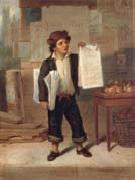 |
James H. Cafferty 
|
|
American, 1819-1869
|
|
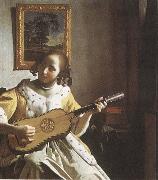 |
james m cain 
|
|
Born: 1 July 1892
Birthplace: Annapolis, Maryland
Died: 27 October 1977
Best Known As: Author of The Postman Always Rings Twice
|
|
 |
James-Goodwyn Clonney 
|
|
British/American, 1812-1867, American painter. He was one of the first generation of American genre painters. His earliest datable work includes two lithographs of urban views and images of birds and animals published in New York between 1830 and 1835. He studied at the National Academy of Design, New York, and exhibited there periodically between 1834 and 1852. The first genre painting he exhibited at the National Academy was Militia Training (1841; Philadelphia, PA Acad. F.A.), although another example, In the Woodshed (1838; Boston, MA, Mus. F.A.), predates it. He also exhibited at the Pennsylvania Academy of Fine Arts (1845 and 1847) and at the Apollo Association and American Art-Union (1841-50).
|
|
 |
Jan Cornelisz Vermeyen 
|
|
(c.1500-1559) was a Dutch Northern Renaissance painter.
According to Karel van Mander he was born in Beverwijk in 1500 and was honored for his career in the service of Charles V. He was a friend of Jan van Scorel and his portrait was engraved by Jan Wierix for Dominicus Lampsonius.
Vermeyen was a painter and tapestry designer, probably a pupil of Jan Mabuse. About 1525 he became Court Painter to Margaret of Austria, regent of the Netherlands at Mechelen and in 1535 he accompanied the Emperor Charles V, at the Conquest of Tunis (1535). This journey supplied him with scenes for later works, including tapestries designed 1545/48 for the Regent, Mary of Hungary. He died in Brussels.
Many portraits are ascribed to him on very little evidence, according to modern scholars.
|
|
 |
Jan Cossiers 
|
|
1600-1671
Flemish
Jan Cossiers Location
Flemish painter and draughtsman. After serving an apprenticeship with his father, Anton Cossiers ( fl 1604-c. 1646), and then with Cornelis de Vos, he went first to Aix-en-Provence, where he stayed with the painter Abraham de Vries (1590-1650/62), and then to Rome, where he is mentioned in October 1624. By 1626 he had returned to Aix and had contact with, among others, Nicolas-Claude Fabri de Peiresc, the famous humanist, who recommended him to Rubens. By November 1627 Cossiers had settled back in Antwerp. The following year he became a master in the Guild of St Luke, and in 1630 he married for the first time; he married a second time in 1640.
|
|
 |
Jan ten Compe 
|
|
painted view of the Town Hall in 18th century
|
|
 |
Jan Van Chelminski 
|
|
1851-1925
|
|
 |
Jan van de Capelle 
|
|
seascape master Dutch Baroque Era Painter, C.1624-1679
|
|
 |
Jan van de Cappelle 
|
|
1624-1679
Dutch Jan van de Cappelle Locations
Dutch businessman, collector, painter, draughtsman and etcher. Though now considered the outstanding marine painter of 17th-century Holland, he was not a professional artist nor a member of the Amsterdam Guild of St Luke. His father owned a successful dye-works in Amsterdam, in which both Jan and his brother Louis were active. Their father enjoyed a long life and probably managed the firm until close to his death in 1674, when Jan inherited it. This left Jan with plenty of spare time to pursue his hobby, painting. He married Annetje Jansdr. (Anna Grotingh) before 1653. He died a widower, survived by his seven children, who inherited his considerable fortune. His last will shows that in addition to the dye-works and immense cash assets, van de Cappelle owned extensive properties and an art collection that must be rated among the most important of his time.
|
|
 |
Janssens van Ceulen 
|
|
Cornelis Janssens van Ceulen (also Cornelius Jonson van Ceulen, Cornelius Johnson, Cornelis Jansz. van Ceulen and many other variants) (bapt. October 14, 1593, London - bur. August 5, 1661, Utrecht) was an English painter of portraits of Dutch or Flemish parentage. He has been described as "one of the most gifted and prolific portrait painters practising in England during the 1620s and 1630s".
|
|
 |
Jasper Cropsey 
|
|
American Hudson River School Painter, 1823-1900
Jasper Francis Cropsey (February 18, 1823 - April 23, 1900) was an important American landscape artist of the Hudson River School.
Cropsey was born on his father Jacob Rezeau Cropsey's farm in Rossville on Staten Island, New York, the oldest of eight children. As a young boy, Cropsey had recurring periods of poor health. While absent from school, Cropsey taught himself to draw. His early drawings included architectural sketches and landscapes drawn on notepads and in the margins of his schoolbooks. After studying architecture for five years, he turned his attention to landscape painting, under the instruction of Edward Maury. He visited England, France, Switzerland, and Italy in 1847, went abroad again in 1855, and resided seven years in London, sending his pictures to the Royal Academy and to the International exhibition of 1862.
After his return home in 1863, he opened a studio in New York, where he resided until 1885, when he removed to Hastings-on-Hudson.
Trained as an architect, he set up his own office in 1843. Cropsey studied watercolor and life drawing at the National Academy of Design and first exhibited there in 1844. A year later he was elected an associate member and turned exclusively to landscape painting in the 1840s, shortly after he was featured in an exhibition entitled "Italian Compositions."
Cropsey married Maria Cooley in May 1847, traveled in Europe from 1847-1849, was elected a full member of the Academy in 1851, and lived in England 1856-1863. During this time he specialized in autumnal landscape paintings of the northeastern United States, often idealized and with vivid colors. One such painting is "The Valley of the Wyoming" set in eastern Pennsylvania. The name of this valley was given to the western state of Wyoming.
He co-founded, with ten fellow artists, the American Society of Painters in Water Colors in 1866.
|
|
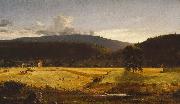 |
Jasper Francis Cropsey 
|
|
(February 18, 1823 - April 23, 1900) was an important American landscape artist of the Hudson River School.
Cropsey was born on his father Jacob Rezeau Cropsey's farm in Rossville on Staten Island, New York, the oldest of eight children. As a young boy, Cropsey had recurring periods of poor health. While absent from school, Cropsey taught himself to draw. His early drawings included architectural sketches and landscapes drawn on notepads and in the margins of his schoolbooks.
Trained as an architect, he set up his own office in 1843. Cropsey studied watercolor and life drawing at the National Academy of Design under the instruction of Edward Maury and first exhibited there in 1844. A year later he was elected an associate member and turned exclusively to landscape painting; shortly after he was featured in an exhibition entitled "Italian Compositions."
Cropsey married Maria Cooley in May 1847, traveled in Europe from 1847-1849, visiting England, France, Switzerland, and Italy. He was elected a full member of the Academy in 1851. Cropsey was a personal friend of Henry Tappan, the president of the University of Michigan from 1852 to 1863. At Tappan's invitation, he traveled to Ann Arbor in 1855 and produced two paintings, one of the Detroit Observatory, and a landscape of the campus. He went abroad again in 1855, and resided seven years in London, sending his pictures to the Royal Academy and to the International exhibition of 1862.
Returning home, he opened a studio in New York and specialized in autumnal landscape paintings of the northeastern United States, often idealized and with vivid colors. Cropsey co-founded, with ten fellow artists, the American Society of Painters in Water Colors in 1866. He resided in the City until 1885, when he removed to Hastings-on-Hudson.
The monument of Jasper Francis Cropsey in Sleepy Hollow CemeteryCropsey's home and studio, Ever Rest, in Hastings-on-Hudson, New York as well as the largest permanent collection of Cropsey's work are open for tours by the Newington-Cropsey Foundation.
Jasper Cropsey died in anonymity but was rediscovered by galleries and collectors in the 1960s. Today, Cropsey's paintings are found in most major American museums, including the National Gallery of Art, the Metropolitan Museum of Art, the Los Angeles County Museum of Art, the Detroit Institute of Arts, the Timken Museum of Art in San Diego, the Honolulu Academy of Arts, the Fine Arts Museums of San Francisco, the Denver Art Museum, and the Museum of Fine Arts, Boston. Works by Cropsey also hang in the White House.
|
|
 |
Jean - Baptiste Carpeaux 
|
|
French Realist Sculptor, 1827-1875.
French Realist Sculptor, 1827-1875.French sculptor, painter, draughtsman and etcher. He was one of the leading sculptors of the Second Empire (1852-70) in France.
|
|
 |
Jean Baptiste Camille Corot 
|
|
1796-1875
Corot Locations
French painter, draughtsman and printmaker.
After a classical education at the College de Rouen, where he did not distinguish himself, and an unsuccessful apprenticeship with two drapers, Corot was allowed to devote himself to painting at the age of 26. He was given some money that had been intended for his sister, who had died in 1821, and this, together with what we must assume was his family continued generosity, freed him from financial worries and from having to sell his paintings to earn a living. Corot chose to follow a modified academic course of training. He did not enrol in the Ecole des Beaux-Arts but studied instead with Achille Etna Michallon and, after Michallon death in 1822, with Jean-Victor Bertin. Both had been pupils of Pierre-Henri Valenciennes, and, although in later years Corot denied that he had learnt anything of value from his teachers, his career as a whole shows his attachment to the principles of historic landscape painting which they professed.
|
|
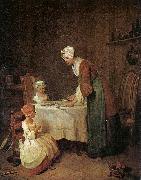 |
Jean Baptiste Simeon Chardin 
|
|
1699-1779
French
Jean Baptiste Simeon Chardin Locations
Chardin was born in Paris, the son of a cabinetmaker, and rarely left the city. He lived on the Left Bank near Saint-Sulpice until 1757, when Louis XV granted him a studio and living quarters in the Louvre.
Chardin entered into a marriage contract with Marguerite Saintard in 1723, whom he did not marry until 1731. He served apprenticeships with the history painters Pierre-Jacques Cazes and Noël-Nicholas Coypel, and in 1724 became a master in the Acad??mie de Saint-Luc.
Upon presentation of The Ray in 1728, he was admitted to the Acad??mie Royale de Peinture et de Sculpture. The following year he ceded his position in the Acad??mie de Saint-Luc. In November of 1731 his son Jean-Pierre was baptized, and a daughter, Marguerite-Agn??s, was baptized in 1733. In 1735 his wife Marguerite died, and within two years Marguerite-Agn??s had died as well.
The Ray, 1728, Mus??e du Louvre, Paris.Beginning in 1737 Chardin exhibited regularly at the Salon. He would prove to be a dedicated academician, regularly attending meetings for fifty years, and functioning successively as counsellor, treasurer, and secretary, overseeing in 1761 the installation of Salon exhibitions.
In 1744 he entered his second marriage, this time to Françoise-Marguerite Pouget. The following year a daughter, Ang??lique-Françoise, was born, but she died in 1746.
In 1752 Chardin was granted a pension of 500 livres by Louis XV. At the Salon of 1759 he exhibited nine paintings; it was the first Salon to be commented upon by Denis Diderot, who would prove to be a great admirer and public champion of Chardin work. Beginning in 1761, his responsibilities on behalf of the Salon, simultaneously arranging the exhibitions and acting as treasurer, resulted in a diminution of productivity in painting, and the showing of replicas of previous works. In 1763 his services to the Acad??mie were acknowledged with an extra 200 livres in pension. In 1765 he was unanimously elected associate member of the Acad??mie des Sciences, Belles-Lettres et Arts of Rouen, but there is no evidence that he left Paris to accept the honor.[8] By 1770 Chardin was the Premiere peintre du roi, and his pension of 1,400 livres was the highest in the Academy.
In 1772 Chardin son, also a painter, drowned in Venice, a probable suicide. The artist last known oil painting was dated 1776; his final Salon participation was in 1779, and featured several pastel studies. Gravely ill by November of that year, he died in Paris on December 6, at the age of 80.
|
|
 |
Jean Charles Cazin 
|
|
1841-1901
French
Jean Charles Cazin Location
Painter and ceramicist. His earliest paintings reveal close affinities with the realist tradition, while his later compositions (mostly landscapes of northern France) demonstrate an awareness of Impressionism and a commitment to recording the changing effects of light and atmosphere. He was sent to England for health reasons but by 1862 or 1863 was living in Paris and active in avant-garde artistic circles. In 1863 he exhibited Recollections of the Dunes of Wissant (untraced), a work based on close observation of the coastline of northern France, at the Salon des Refuses. He enrolled at the Ecole Gratuite de Dessin under Horace Lecoq de Boisbaudran, where he became friends with Alphonse Legros, Thodule Ribot, Henri Fantin-Latour and Leon Lhermitte, all of whom adopted Boisbaudran method of developing paintings from memory as a way of heightening perceptions. During this period Cazin also met Marie Guillet, whom he married in 1868.
|
|
 |
Jean Charles Tardieu 
|
|
French Painter, 1765-1830
|
|
 |
Jean Clouet 
|
|
French Painter, ca.1485-1541
painter. He was chief painter to Francis I and produced many pastel portraits of members of the French court. Clouet was one of the best 16th-century portrait painters, both incisive and delicate in the psychological characterization of sitters. His drawings are simple, broad, and subtle; his paintings are fresh in colour, subdued in modeling, and minute in execution. He was celebrated in his lifetime as the equal of Michelangelo. His son Francois Clouet (c. 1515 ?C 72) took his place as official painter to Francis I in 1540.
|
|
 |
Jean Cotelle 
|
|
Jean Cotelle
Jean Cotelle, 'the younger', was a painter and engraver, born in Paris in 1645. He received his early instruction from his father, Jean Cotelle, and eventually visited Italy. On his return he devoted himself to his profession, producing historical paintings, miniatures, and occasionally etchings. His chef-d'oeuvre was the 'Marriage at Cana,' painted in 1681 for the cathedral of Notre-Dame. There are by him at Versailles several views in the gardens of that palace. He etched a plate representing 'Our Lord on the Mount of Olives,' and a series of seven scenes from the history of Venus. He was admitted into the Academy in 1672, and died at Villers-sur-Marne in 1708.
|
|
 |
Jean Cousin THe Elder 
|
|
Sens ca .1490-Paris ca 1560
|
|
 |
Jean Henri De Coene 
|
|
Jean Henri De Coene, a Belgian painter of genre and historical subjects, was born at Nederbrakel in 1798.
|
|
 |
Jean Simeon Chardin 
|
|
(2 November 1699 - 6 December 1779) was an 18th-century French painter. He is considered a master of still life, and is also noted for his genre paintings which depict kitchen maids, children, and domestic activities. Carefully balanced composition, soft diffusion of light, and granular impasto characterize his work.
Chardin was born in Paris, the son of a cabinetmaker, and rarely left the city. He lived on the Left Bank near Saint-Sulpice until 1757, when Louis XV granted him a studio and living quarters in the Louvre.
Chardin entered into a marriage contract with Marguerite Saintard in 1723, whom he did not marry until 1731. He served apprenticeships with the history painters Pierre-Jacques Cazes and Noël-Nicolas Coypel, and in 1724 became a master in the Academie de Saint-Luc.
According to one nineteenth-century writer, at a time when it was hard for unknown painters to come to the attention of the Royal Academy, he first found notice by displaying a painting at the "small Corpus Christi" (held eight days after the regular one) on the Place Dauphine (by the Pont Neuf). Van Loo, passing by in 1720, bought it and later assisted the young painter
|
|
 |
Jean-Baptiste Camille Corot 
|
|
(July 17, 1796 - February 22, 1875) was a French landscape painter and printmaker in etching. Corot was the leading painter of the Barbizon school of France in the mid-nineteenth century. He is a pivotal figure in landscape painting and his vast output simultaneously references the Neo-Classical tradition and anticipates the plein-air innovations of Impressionism.
|
|
 |
Jean-Baptiste Capronnier 
|
|
(1814-1891) was a Belgian stained glass painter. Born in Brussels in 1814, he had much to do with the modern revival of glass-painting, and first made his reputation by his study of the old methods of workmanship, and his clever restorations of old examples, and copies made for the Brussels archaeological museum. He carried out windows for various churches in Brussels (including the Église Royale Sainte-Marie), Bruges, Amsterdam and elsewhere, and his work was commissioned also for France, Italy and England. At the Paris Exhibition of 1855 he won the only medal given for glasspainting. He died in Brussels in 1891.
|
|
 |
Jean-Baptiste Carpeaux 
|
|
(May 11, 1827 - October 12, 1875) was a French sculptor and painter.
Born in Valenciennes, Nord, son of a mason, his early studies were under François Rude. Carpeaux entered the Ecole des Beaux-Arts in 1844 and won the Prix de Rome in 1854, and moving to Rome to find inspiration, he there studied the works of Michelangelo, Donatello and Verrocchio. Staying in Rome from 1854 to 1861, he obtained a taste for movement and spontaneity, which he joined with the great principles of baroque art. Carpeaux sought real life subjects in the streets and broke with the classical tradition.
While a student in Rome, Carpeaux submitted a plaster version of Pe - heur napolitain e la coquille, the Neapolitan Fisherboy, to the French Academy. He carved the marble version several years later, showing it in the Salon exhibition of 1863. It was purchased for Napoleon III's empress, Eugenie. The statue of the young smiling boy was very popular, and Carpeaux created a number of reproductions and variations in marble and bronze. There is a copy, for instance, in the Samuel H. Kress Collection in the National Gallery of Art in Washington D.C.. Some years later, he carved the Girl with a Shell, a very similar study.
In 1861 he made a bust of Princess Mathilde, and this later brought him several commissions from Napoleon III.
|
|
 |
Jean-Baptiste Corot 
|
|
1796-1875
was a French landscape painter and printmaker in etching. Corot was the leading painter of the Barbizon school of France in the mid-nineteenth century. He is a pivotal figure in landscape painting and his vast output simultaneously references the Neo-Classical tradition and anticipates the plein-air innovations of Impressionism. Camille Corot was born in Paris in 1796, in a house at 125 Rue du Bac, now demolished. His family were bourgeois people his father was a wigmaker and his mother a milliner and unlike the experience of some of his artistic colleagues, throughout his life he never felt the want of money, as his parents made good investments and ran their businesses well. After his parents married, they bought the millinery shop where she had worked and he gave up his career as a wigmaker to run the business side of the shop. The store was a famous destination for fashionable Parisians and earned the family an excellent income. Corot was the middle of three children born to the family, who lived above their shop during those years. Corot received a scholarship to study in Rouen, but left after having scholastic difficulties and entered a boarding school. He was not a brilliant student, and throughout his entire school career he did not get a single nomination for a prize, not even for the drawing classes. Unlike many masters who demonstrated early talent and inclinations toward art, before 1815 Corot showed no such interest. During those years he lived with the Sennegon family, whose patriarch was a friend of Corot's father and who spent much time with young Corot on nature walks. It was in this region that Corot made his first paintings after nature. At nineteen, Corot was a big child, shy and awkward. He blushed when spoken to. Before the beautiful ladies who frequented his mother's salon, he was embarrassed and fled like a wild thing Emotionally, he was an affectionate and well-behaved son, who adored his mother and trembled when his father spoke. When Corot's parents moved into a new residence in 1817, the twenty-one year old Corot moved into the dormer-windowed room on the third floor, which became his first studio as well. With his father's help he apprenticed to a draper, but he hated commercial life and despised what he called "business tricks", yet he faithfully remained in the trade until he was 26, when his father consented to his adopting the profession of art. Later Corot stated, I told my father that business and I were simply incompatible, and that I was getting a divorce. The business experience proved beneficial, however, by helping him develop an aesthetic sense through his exposure to the colors and textures of the fabrics. Perhaps out of boredom, he turned to oil painting around 1821 and began immediately with landscapes
|
|
 |
Jean-Baptiste-Camille Corot 
|
|
was a French landscape painter and printmaker in etching. Corot was the leading painter of the Barbizon school of France in the mid-nineteenth century. He is a pivotal figure in landscape painting and his vast output simultaneously references the Neo-Classical tradition and anticipates the plein-air innovations of Impressionism.
|
|
 |
jean-Baptiste-Simeon Chardin 
|
|
1699-1779
was an 18th-century French painter. He is considered a master of still life.Chardin was born in Paris, the son of a cabinetmaker, and rarely left the city. He lived on the Left Bank near Saint-Sulpice until 1757, when Louis XV granted him a studio and living quarters in the Louvre.Chardin entered into a marriage contract with Marguerite Saintard in 1723, whom he did not marry until 1731.He served apprenticeships with the history painters Pierre-Jacques Cazes and Noël-Nicholas Coypel, and in 1724 became a master in the Academie de Saint-Luc. Upon presentation of The Ray in 1728, he was admitted to the Academie Royale de Peinture et de Sculpture. The following year he ceded his position in the Academie de Saint-Luc. In November of 1731 his son Jean-Pierre was baptized, and a daughter, Marguerite-Agn's, was baptized in 1733. In 1735 his wife Marguerite died, and within two years Marguerite-Agn's had died as well.Beginning in 1737 Chardin exhibited regularly at the Salon. He would prove to be a 'dedicated academician', regularly attending meetings for fifty years, and functioning successively as counsellor, treasurer, and secretary, overseeing in 1761 the installation of Salon exhibitions. In 1744 he entered his second marriage, this time to Françoise-Marguerite Pouget. The following year a daughter, Angelique-Françoise, was born, but she died in 1746. In 1752 Chardin was granted a pension of 500 livres by Louis XV. At the Salon of 1759 he exhibited nine paintings; it was the first Salon to be commented upon by Denis Diderot, who would prove to be a great admirer and public champion of Chardin's work.Beginning in 1761, his responsibilities on behalf of the Salon, simultaneously arranging the exhibitions and acting as treasurer, resulted in a diminution of productivity in painting, and the showing of 'replicas' of previous works.In 1763 his services to the Academie were acknowledged with an extra 200 livres in pension. In 1765 he was unanimously elected associate member of the Academie des Sciences, Belles-Lettres et Arts of Rouen, but there is no evidence that he left Paris to accept the honor.By 1770 Chardin was the 'Premiere peintre du roi', and his pension of 1,400 livres was the highest in the Academy.In 1772 Chardin's son,
|
|
 |
Jean-Joseph Benjamin-Constant 
|
|
(also known as Benjamin Constant), born Jean-Joseph Constant (10 June 1845 - 26 May 1902), was a French painter and etcher best known for his Oriental subjects and portraits.
Benjamin-Constant was born in Paris. He studied at the Ecole des Beaux-Arts in Paris, where he was a pupil of Alexandre Cabanel. A journey to Morocco in 1872 strongly influenced his early artistic development and lead him to produce Romantic scenes under the spell of Orientalism. Among his noted works in this vein are Last Rebels, Justice in the Harem (both in the Luxembourg Gallery), Les Cherifas, and Moroccan Prisoners (Bordeaux). His large canvas, The Entrance of Mahomet II into Constantinople (Toulouse Museum), received a medal in 1876.
After 1880, he changed his manner, devoting himself to mural decorations and to portraits. Prominent examples include the great plafond in the Hôtel de Ville, Paris, entitled Paris Convening the World; his paintings in the New Sorbonne, representing Literature, The Sciences, and the Academy of Paris; and the plafond of the Opera Comique theatre. He was distinguished as a portrait painter, especially in England, where he was a favorite of the aristocracy. His portrait Mons fils Andra (Luxembourg) was awarded a medal of honor at the Salon in 1896.
Benjamin-Constant painted Pope Leo XIII, Queen Alexandra of England (1901), Lord John Lumley-Savile, and Henri Blowitz (1902). He was made a member of the Institute in 1893, and was a commander of the Legion of Honor. He visited the United States several times, and painted a number of portraits. The Metropolitan Museum of Art in New York owns a large mural decoration by Benjamin-Constant entitled Justinian in Council.
|
|
 |
jean-simeon chardin 
|
|
Jean-Baptiste-Simeon Chardin, född 2 november 1699 i Paris, död 6 december 1779 i Paris, var en fransk målare. Mästare på stilleben och genrebilder.
Chardins blygsamma läggning, personliga stil och valet av motiv från medelklassens vardagsliv försenade hans succe i Bouchers och Fragonards Frankrike, men 1728 invaldes han i Franska akademin samtidigt som hans genrebilder genom gravörernas försorg blev populära.
När 1700-talets hovkonst inte längre var populär, steg Chardins popularitet. De enkla kompositionerna, de ensamma gestalterna i form av köksflickor i arbete eller barn försjunkna i sina lekar, påverkade målare som på 1800-talet målade vardagsmotiv. Manet influerades starkt av den lugna klarheten i Chardins stilleben, liksom Courbet hade påverkats före honom.
|
|
 |
jeremy collier 
|
|
1650 C 1726, English clergyman. Collier was imprisoned as one of the nonjurors, who refused to pledge allegiance to William III and Mary II. He later was outlawed (1696) for absolving on the scaffold two of those involved in the assassination plot against William. Collier's principal fame comes from his Short View of the Immorality and Profaneness of the English Stage (1698) and Ecclesiastical History of Great Britain (1708, 1714). In 1713 he was ordained a nonjuring bishop.
|
|
|
|
|
|
|
|
|
| Wholesale China Oil Painting Wholesale Oil Painting China Xiamen Portrait Reproduction on canvas Chinese Oil Painting Wholesale USA Oil Painting |
|
|
|
|